#FU MANCHU The Action is Go
Explore tagged Tumblr posts
Text
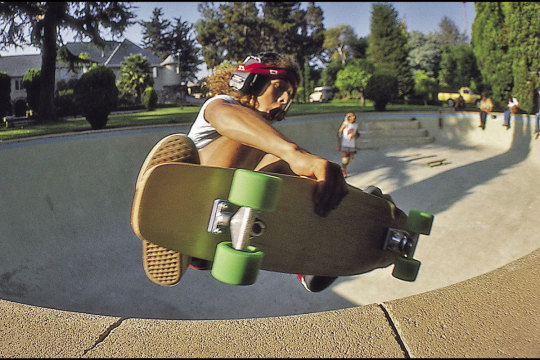
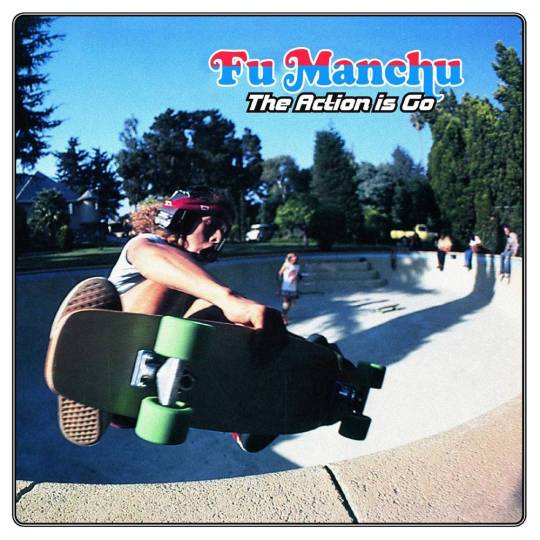
TONY ALVA -- IMMORTALISED BY THE FU (AND VICE VERSA): STAY HEAVY!!
PIC(S) INFO: Spotlight on front cover of "The Action is Go" (Mammoth Records, 1997), the fourth album by American stoner rock band FU MANCHU, featuring a photo of Z-boy Tony Alva poolriding the Dog Bowl, 1525 San Vicente Blvd, Santa Monica, CA. 📸: Glen E. Friedman
Source: http://beachpartyattitude.blogspot.com/2013/06/the-action-is-go.html.
#The Action is Go#FU MANCHU The Action is Go#FU MANCHU The Action is Go 1997#Stoner rock#Tony Alva#Frontside Air#Skateboarding#Glen E. Friedman#Classic Skateboarding#Retro Skateboarding#Dog Bowl#Santa Monica#90s rock#Poolriding#Summer Mood#Alva#Vintage Style#American Style#Heavy groove#Vintage Skateboarding#FU MANCHU#Z-boys#The Action is Go 1997#Fuzz rock#Sleeve Art#FU MANCHU 1997#FU MANCHU band#Z boys#Glen E. Friedman photography#Santa Monica CA
10 notes
·
View notes
Text
youtube
🤘
3 notes
·
View notes
Note
I was reading one of your posts that crosslinked to another post about someone named the Grey Claw, but the link wasn't working. What's the Grey Claw all about?
I was planning to hold off talking about him until I could finish translating his comic or wrote a story with him proper, plans I still intend to get around to but are gonna be on ice for a long while. So in the meanwhile, let's finally set the record about this guy.
Said to be the star of Brazil's first horror comic, he is unarguably the first Brazilian supervillain, and I'll make an argument that he may very well be The First Comic Book Supervillain proper, inspired by the pulp master villains but something much different than the drab Fu Manchu clones of the time, something new and costumed and strange and fantastical in ways that were years if not decades ahead of his time. Predating the first recognized American supervillains in comics, at the midpoint between Fu Manchu and Doctor Sivana, between Fantomas and The Joker, between Doctor Quartz and Lex Luthor, there is: The Grey Claw.

Murders, underground connections, secret laboratories, opium dens, a secret society of crime and a mysterious super-villain challenging all of police and society. São Paulo was still in it's quiet beginnings, but even then, it dreamed of being a grand shadowy metropolis, like the ones heard about in movies, pulps and North-American comic books.
And that dream made the success of The Grey Claw series in the 1930s. For months, paulista readers eagerly followed the perils of Inspector Frederic Higgens at the hands of The Grey Claw's semi-anarchist gang, with exotic characters such as the robot Flag and the sensual Dame in Black.
Considered by many to be the first Brazilian horror comic - due to it's plot full of monsters, mummies, grave defilings and mentions of life after death - The Grey Claw is a direct spawn from the seedy and mysterious texts of north-american pulp magazines. Soon, those masked avengers and horrific villains in non-stop action would reach the world of comics, giving birth to the superhero revolution. - The City and it's Monster, by Worney Almeida de Souza
The Grey Claw was the star of a comic published in newspaper A Gazetinha starting July 1937, just short of a full year before Superman's debut in June 1938, and it would run for a hundred installments until wrapping up it's story circa 1939. The same newspaper would eventually debut both Superman and The Phantom (second only to Superman and maybe Batman in terms of imitators worldwide among Golden Age superheroes, and I say maybe because they overlap a bit but The Phantom was definitely the go-to superhero to rip off basically everywhere outside of the States) to Brazilian audiences, running alongside The Grey Claw during his brief run. The strip is a police procedural that gradually turns into a sci-fi horror story, a pastiche of film serials and pulp novels that focuses on the titular strange, powerful masked villain running amok in a seedy metropolitan area, and a police detective's efforts to uncover who is behind said villain.

The basic skeleton of it is a fairly cut-and-dry police procedural with a square-jawed Sherlockian policeman investigating a string of calling-card murders with more suspects and victims picking up along the way. Our heroes are mostly colorless and dull archetypes, although the protagonist Higgins is amusingly dickish at several times and I'll go to bat for the female lead Kay Tornhill, she's a fairly progressive character in spite of limited screentime as the detective's partner (not romantically, she joins the investigation to protect her younger brother from the Claw). She's a skilled fencer / marksman / equestrian / swimmer who doesn't really get to show these talents in the story, but they make a point of bringing it up, and I think Kay's presentation probably did the most in convincing people for decades that this comic was penned by a woman under a male name, because, well just look at her.
But as is Pulp Supervillain Lead tradition, it is the villain who has more than enough charisma to spare to carry us through, and a lot of what makes The Grey Claw feel distinct is that he winds up remixing stock pulp/serial villain traits in novel ways, the result of him making his debut in a fairly new and developing medium and growing stranger as the issues develop as he takes center stage more and more. Everytime he shows up, he brings with him things like televised death traps (television hadn't yet been brought to Brazil), underground torch-lit lairs, rabid ape monsters in chains who used to be humans, and a gigantic automaton who walks around making turkey noises and killing everything in sight unless reigned in by The Grey Claw, who names it "FLAG" and treats him with great fondness as if he were a best friend and a sidekick and a dog all in one and bemoans that one day, he will be able to give his berserk death machine friend the power of speech.

FLAG! FLAG! It is I, FLAG! Calm yourself, FLAG!
My poor FLAG! Some day, I shall give you the usage of speech...
Here's one thing about the character upfront: The story was drawn by Renato Silva (who also did Nick Carter stories) and written by Francisco Armond, but nobody knows who Francisco Armond is. For a while, the most likely candidate was Helena Ferraz, a poet and co-editor/director of the paper who had already published under the male pseudonym Alvaro Armando (named after her two sons), but relatives of hers confirmed it wasn't her, and so currently nobody knows who wrote this. I actually still have no idea who, if anyone, currently owns the rights to The Grey Claw, because although he's had a recent reboot (by the same creator of Doutrinador and in the exact same vibe, which means it's dogshit and I will not entertain it), he's long passed the point where he should be public domain.
The comic was a great success for it's time and would achieve a level of fame none of it's contemporaries would by being reprinted internationally. In 1939, it was reprinted without permission by Mexican editor Sayrol in 1939 and made it's way to European publishers through there. Between 1944-1947 it had a very popular run in Belgian magazine "Le Moustique", and he was adapted to France under the name "La Griffre Grise", which is where I discovered the character while looking for French pulp characters. Unsurprisingly, the character was never credited as a Brazilian creation, and for 50 or so years went almost completely undiscovered by even the most hardcore researchers.
Even in Brazil, nobody knows about this guy, and it was only in 2011, 74 years after his debut, that the character's entire saga was finally collected and reprinted in trade paperback by Editora Conrad. It's not cheap and it's really hard to find and order, completely out of stock in most online stores, but I got it as a birthday gift from my sister a couple years ago. I have it on hand right now to help put this post together.

It's a fairly weird comic that's in many ways aged really poorly but also tapped into some veins superhero comics and future supervillains would take a long while to even approach. The dialogue is a couple steps clunkier than even your average Golden Age comic, almost impenetrably outdated with Portuguese linguistics (a poisoned character saying out loud "Oh no! I've just been narcotized!") and weird malapropist English terms hastily translated and inserted in, and conveying the feel of it is even beyond my own skills at translating. It's a unique time capsule of how Brazil was still adapting to rapidly developing times, recently loosening up from centuries-spanning shackles of Portuguese and Spanish colonialism and with a newfound input of foreign media in pulps and serials and theater, and adapting and developing new subcultures and ways of expression as a result.
This was one of the first times a Brazilian comic would play around this much with USAmerican tropes and archetypes (cultural imports from the USA were all extremely new and viewed as a hot new alternative to European art and culture that had otherwise been the dominant form), a São Paulo-published comic set in a seedy, Depression-choked American metropolis, a big monument of brick and poison and inequality, which is exactly what São Paulo would become. There is something oddly alien and prescient about The Grey Claw because it's rooted in a fictionalized fantasyland idea of 1930s New York, that would nevertheless predate São Paulo's trajectory into becoming the country's big American-Style Urban Center, over the decades later when it would be the USAmericans' turn to tighten those colonialist shackles back on.
The dialogue also makes it pretty funny to read as a result and especially when the villain shows up, because The Grey Claw himself is pretty goddamn funny. Not just funny: I think his characterization is actually pretty damn impressive, and it's certainly the main draw of the thing for me. There's one sequence I'm going to post the whole page to be appreciated. I can't scan it so you'll just have to take my word as is that this is the whole page.
For context: It is revealed that The Grey Claw has been on a mad quest to unlock the mysteries of life and death via a formula that can bring the dead back to life. He monologues quite intensely about having unveiled and unlocked the secrets, saying to FLAG that he was the first step in giving life and intelligence into inanimate matter ("You would be a perfect creation, if only you were able to express your feelings", he says, to the horrid gurgling automaton who murders everything in sight), but that this time, he shall perfect the breath of life.
But it is eventually revealed, when he is exposed as Dr James Stone (a "famed young chemist, one of the most well-liked men around town") after his explosive demise, that he had in fact stolen the formula's recipe from a former partner, Professor Curberry. Curberry was the ape monster he kept chained in the basement, and that he visited in order to whip while it writhed in chains, with the narrative stating The Claw was "blinded by hate" towards him. At the end, it's revealed that Curberry's corpse coming back to life as a half-man-half-ape monster was a side effect of The Grey Claw "getting the dosage wrong", and we're just gonna ignore the can of worms that ending brings to focus on when The Grew Claw actually succeded.
For his test subject, he picked the corpse of the scientist's secretary he murdered within the 2nd strip, over a week well into death, and injects her at the dawn of midnight. And I'm gonna have to transcribe it:

Mid-night at last! The "Claw" begins the grand experiment.
The ghost's hand shakes slightly as he injects the licor of life in the dead woman's arms. And this is the first time the steely nerves of that insensitive creature have ever faltered.
"Twenty four minutes and...she'll be back to life! Ah, this time the triumph will be complete!"
"Will I fail yet again? No, failure is not possible. However, the experiment realized with Curberry was definitive...how horrible it would be if the experiment failed again!"
"It would be horrible! But no! If I fail, I will not allow her to survive...Yes! I shall exterminate her! Curberry and Mac-Flagan were more than enough!"
The minutes drizzle out slowly. As the pointers walk across, the mysterious ghost feels his nervousness grow.
They dedicated an entire page's worth just to The Grey Claw stressing and worrying and having a breakdown over the prospect of his formula not working again. But he does succeed, and the secretary comes back to life devoid of any memories and in great shock. Here's how the "insensitive creature" reacts

Despite his great dominion over his own nerves, the "Claw" can barely repress his restlessness. The living dead woman stumbles around her with a look of fright.
DAME IN BLACK: "What an emptiness in my head! It's all confused, scrambled, obscured!"
THE GREY CLAW: "This time I've won completely, FLAG!"
He later tells her that, with no memories of her own, she might as well not "cling to the past" and instead join him as his "Dame in Black". But in the aftermath of this, while he's busy boasting and jeering that the world belongs to him now, FLAG immediately zeroes in and tries to maul the woman before The Claw shoos him away. And then in the next strip, he writes in his diary about how his two besties are getting along now-
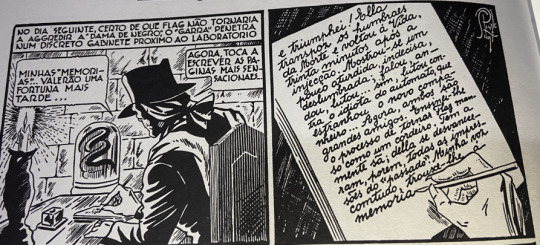
The next day, certain that FLAG would no longer try assaulting the "Dame in Black", the "Claw" penetrates a discreet cabinet next to the laboratory
"My memories...they shall be worth a fortune later..."
"I have triumped! She transcended the throes of death and returned to life, thirty minutes after the injection. She showed herself a bit stunned, undecided, wowed; she spoke, she walked, she fought…yes, she fought the idiot automaton, who was startled by the new companion…But now, they are both great friends."
"I have taught her the process of turning FLAG docile as a lamb. She is of sane mind; her mind has shed, however, all impressions of the "past". My voice, however, brought her memory-"
Did I tell you guys already that, before the police blows the two up, FLAG ultimately mauls The Grey Claw to death while his last words are him desperately trying to get the robot to calm down, saying "It's me!" instead of fleeing? I'm posting like one highlight, but to post all of them would be to post basically every time this character shows up in the story.
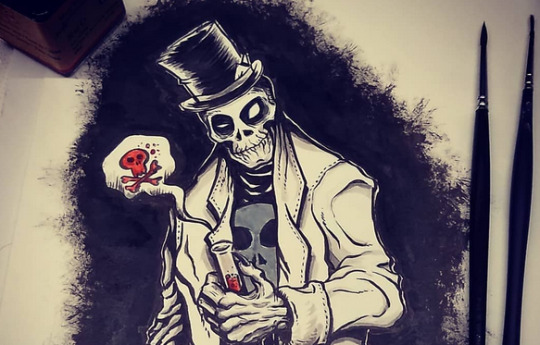
(Art by @zanzooeditorial)
There's just such a fascinating mismatch between how the narration and everyone sees him, as this stone cold invincible death-dealer turned death-master who holds the entire country in a grip of terror, and his characterization when he's actually on-screen going about his affairs. The narrative goes through lengths to paint him as an unfeeling soulless monster that is almost patently contradicted with most of what he says and does in-text, which veers widly between pitiable and even sympathetic to, actually worse than if he was fully pragmatic chessmaster genius the police perceives him as, and it's not even really played for laughs, it's more like a side effect of this being published peacemeal over 2 years and shooting for new directions and thus contradicting itself. He's afforded this emotional range that's just really unheard of, not just in the pulp villains he's based on but in all the Golden Age supervillains that came after him, it's something that only really started catching on with Marvel and their attempts to add extra dimension to their villains.
The Grey Claw is a brutal murderer and a cutthroat terrorist who has an innocent woman shot in the heart within the second page, and he's a wisecracking goofball who delighs in showing off his advanced intellect and machinery before his police nemesis. He commands vast invisible communications networks and armies of brutal thugs, and then he writes diaries and plays pranks and poses dramatically. He is a vicious man who turned his former partner into a mutant ape and keeps him locked up and whipped while constantly berating and cursing him ("Ah Ah Ah! I wish your university colleagues could see you now!"), but he did forsake victory and spared his worst enemies from a horrible end to save the life of a woman he liked among them. He is a deeply lonely gothic dweeb who casually engages in constant banter with the monstrous unresponsive automaton, whom he asks for input and talks to and holds tight in moments of emotion or camraderie that is entirely one-sided on his end, he barely restrains it from murdering everything in sight at all times and winds up being mauled to death the second that grip is loosened. He has one friend in the whole entire world and it's the one he made himself.
He is desperately driven to prove himself and have that blasted resurrection formula he's been developing for years work, even though we learn that it was apparently stolen from someone else the whole time and he was just, what, passionately pretending to himself that it was his life's work? We never get to see his face, only a last-minute identity as a respectable young chemist and "the last suspect anyone would have", and given he was indeed able to reverse death and decay, seemingly permanently, it would have been extremely easy for the series to continue, and for The Grey Claw to come back again and again as many times as it took.
He is humorous and childish and absurd and even quite likeable, but the bodies do not stop piling near him, and the more he shows up, the weirder and bloodier things get, until what began as a bog-standard police whodunit ends with a violent struggle between a former professor turned bloodied giant ape man and a titanic lumbering murder robot deep within an underground dungeon system, where said murder robot proceeds to slaughter everything in sight including the Dr Frankenstein-gangster-pirate who created him, as the police throws dynamite at them because nothing else has worked so far in stopping them.
By all means, The Grey Claw had everything necessary and then some to make it into the biggest leagues of supervillain history, on the strength not just of his initial outing but his inspired characterization and great success and popularity by his time. Today he's remembered only among diehard afictionados and collectors, for spearheading many firsts within Brazilian comics and being one of the very, very few figures among Brazilian superheroes/supervillains to achieve any kind of fame at all. The scene and history when it comes to Brazilian superheroes, and reasons for the lack thereof, is a topic for another day.
Some fans have tried boosting the character's rep by claiming he was an influence on several marginally better-known characters such as Marvel's Blazing Skull or the nascent villain protagonist genre of comics that would pop up throughout Europe in the 50s-60s, but even I'll say that's a stretch too far. Records show The Grey Claw was popular in his time and region for sure, popular enough to be reprinted without credit across the globe and popular enough to be remembered and redrawn in present day (can't discount the strength of a good design, at least), but he was an anomaly at the end, a missing link untethered and unprotected from time.
A gothic horror alchemist who skulks around medieval dungeons, weaponizing every latest technological advancement and social anxiety to his advantage and even some that didn't really exist yet. A totem of death obsessed with life, the first comic book villain to surpass death if only for a moment, an inhuman murderous monster who turns out to be as painfully human as it gets. A skull-faced harbinger of death who foregoes the cloak and scythe to don a panama hat and fancy apparell and The Chest Logo Of His Persona and Brand. Just one year before some gringo strongman was doing that but with circus colors and a letter instead.
Pfah, fashion visionaries never get their due in time. But if conquering death was a trivial task for The Fascinora, conquering time and returning to his true self should be achievable in no time at all!
Ah Ah Ah!...
Give or take some 90 years, maybe.

(Art by @necronauta)
#replies tag#pulp heroes#pulp villains#brazilian comics#the grey claw#o garra cinzenta#brazilian characters#superhero#horror#supervillain
44 notes
·
View notes
Text
Spider-Man: Comics Recommendations (The Sixties)
MASTERPOST
So I just finished reading The Amazing Spider-Man comics from the Sixties (aside from about 20-30 issues in the Ditko era). Want to know what's worth a read? Probably everything, in a way, but here are my recommendations in chronological order under the cut, and if you can't be bothered, here's a quick summary:
ASM #1, Ann #6, ASM #39-40, ASM #47, #50-52, #53-61, SSM #2, Ann #4, ASM #67, #68-70, #75, #78-79.
(In bold: what I particularly loved.)
Issue #1. It's a classic. Amazing Fantasy #15 isn't so interesting. It features a few different stories so it's already a meaty part. Please be aware that this era is very verbose and the art is... what it is. Read a few issues from that era here and there, maybe read issues 31-33 ("If This Be My Destiny...!") but you quickly get the idea.

2. Annual 1: Dozens of cameos, Doc Ock uses Bluetooth, plot twists, it feels like a greatest hits issue.

3. The Green Goblin diptych: Issues #39-40 AND/OR Spectacular Spider-Man #2 (which partly retells it, and adds to it). For the first, it's the start of Romita Sr. taking over Ditko as the main artist (although he tries to keep the same visual style for his first few issues). The Green Goblin discovers Spider-Man's identity and reveals his own... and in SSM#2, this is retold with better art, as well as more story.


The difference in style is striking and SSM2 is definitely one of my favorites. If you hesitate, pick SSM2.
Maybe you can read issue #42 to see Mary Jane's iconic and long-awaited first appearance, but the issue itself isn't that good.
4. Issue 47: Kraven shoots lasers with his titties, and Peter and Harry become roommates. Enough said. If you enjoyed it, you can read the next two issues as well since they continue the storyline, but they're less fun.
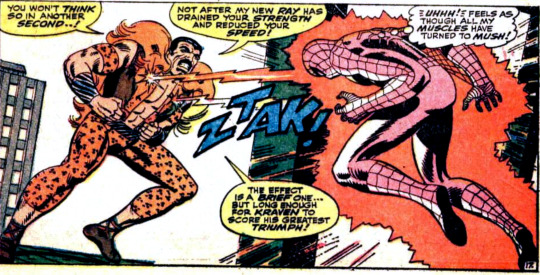
5. Spider-Man No More (Issues 50 to 52): Another iconic storyline. The mob plot would be a bore if not for a specific character, but Peter has had enough of being Spider-Man and the art is gorgeous. #52 in particular is great. The original comics have different coloring from the scanned, cleaner version, just FYI.
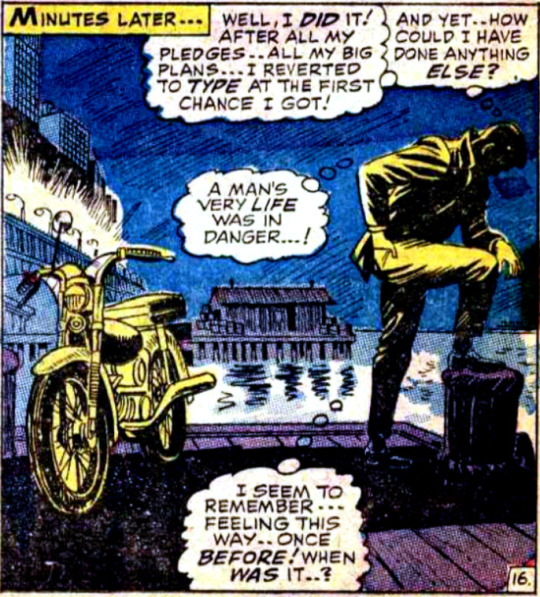
6. Annual 4: Spidey and the Human Torch team-up against two mysterious villains... The two heroes often pair-up, and I really enjoyed this one so here you go! Plus, you get to see Peter and Harry's apartment in details in a double-spread, as well as the cast in the iconic coffee shop.
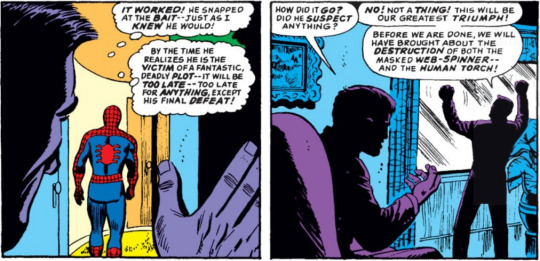
7. What a Tangled Web We Weave (Issues 53 to 61): So here's an extract from my read-through:
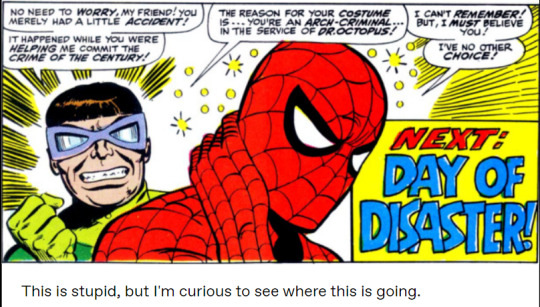
In this batch, we have Dr. Octopus drinking tea with Aunt May, and Spidey getting amnesiac, which influences his hero life and his soap opera daily life.
I was very invested in the storyline, so that's why I'm recommending all of it. If you're a soap fan, read it! And you can add Marvel Super-Heroes 14 as a treat. It's a weird issue, but imo it's a worthwhile read.
8. Issue 67: By this point, the stories are pretty much consistently entertaining, but this issue has a very nice fight with Mysterio. It's a visual treat. Maybe read the previous one if you want context.
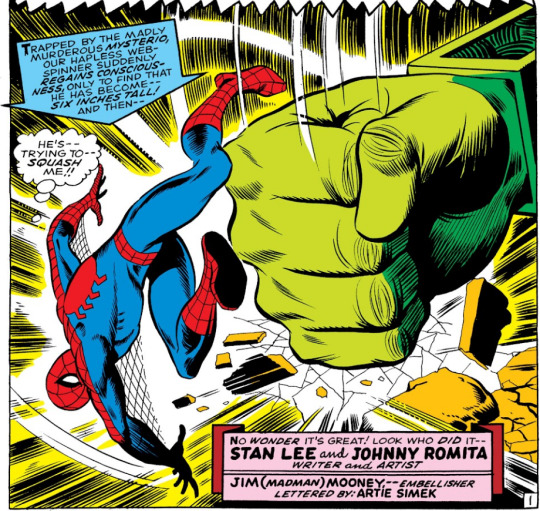
9. The Clay Tablet Arc but specifically #68-70 & 75. Peter gets involved in politics, Civil Rights are discussed, Jameson gets his due, Harry gets a moustache inspired by Fu-Manchu. However, the villains aren't compelling and the mystery of the tablet only gets interesting as it is resolved, hence why you can skip a bunch of issues. Ideally, you'd read everything, but hey, I'm only putting the best out there.

10. The Night of the Prowler (Issues #78-79): One of the more interesting characters introduced this decade! Aside from that, the balance of soap and action is perfect. The art is awesome too. #80 is also fun.

gosh he's so pretty
#spider-man#peter parker#comics#recommendation#guide#green goblin#the amazing spider-man#Stan lee#steve ditko#john romita sr#The Prowler
4 notes
·
View notes
Text
“ The Action Is Go”, Fu Manchu
1 note
·
View note
Photo
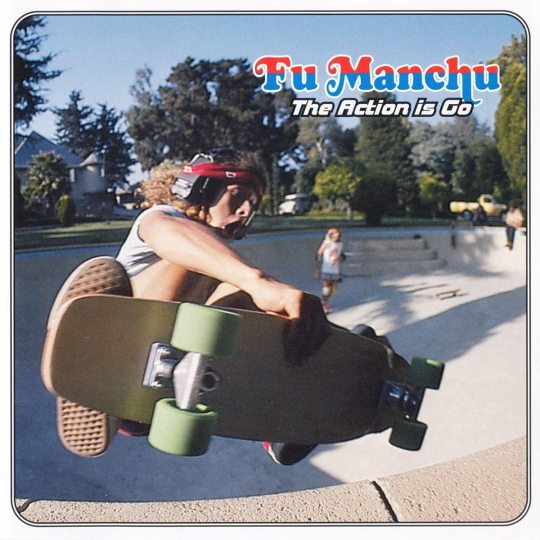
Fu Manchu - The Action Is Go
7 October 1997
21 notes
·
View notes
Text


my brother sent me some songs from this band, Fu Manchu, they’re so fucking cool man!!!!!
im literally addicted to Unknown World
3 notes
·
View notes
Text
Jokerz
The Joker has been believed dead for many years, but imitators popped up afterward and were swiftly dealt with by the Bat-clan. Then, a gang form made of thugs who took the Joker's terrible reputation as an emblem dubbed "The Jokerz", or "Clowns”. It’s largely a loose affiliation with no clear-set leaders outside of small groups of them (usually 3-6 at a time). Jokers stylize their tags, weapons, and clothing in honor of the madman. Some have even managed to get a hold of the dangerous Joker Toxin and use it to ghastly effect. The gang is slightly international, with a group of them appearing in Tokyo as well as New York.
They are sometimes equipped with Razor Cards, Death Buzzers, and other ‘gag’ weapons, or weapons disguised as everyday ‘clown’ regalia.

Name: The Joker Date of Birth: Unknown Motivation: Really? Where would the fun be in telling you that? Critter Type: Human? Attributes: Str 3, Dex 4, Con 3, Int 5, Per 5, Will 5 Ability Scores: Muscle 12, Combat 16, Brains 18, Life Points: 49 Drama Points: 10 Special Abilities: Hard to Kill 5, Deranged Cruelty, Obsession (Batman), Attractiveness -1, Adversary (Innumerable), Fast Reaction Time, Contacts (Criminal) 5, Status (The Joker!) 4, +3 Science Name - Score - Damage – Notes Misdirect/Distract - 18 - None - Test vs Notice/Brains to drop target's Dodge to 0 for next attack. Buzzer (Tazeer) - 16 - 9 - -2 to all actions, KO resist Death Buzzer - 16 - 5 – Survival Test at -4, KO resist at -8 Punch - 16 - 10 – Bash Kick - 15 - 11 – Bash Acid Splash - 16 - 9 - Fire damage, lasts for 1 turn per SL. Pistol - 16 - 16 - Bullet Or Slash Stab for Gag Gun Flower Gasser - 16 - None - Joker Toxin Playing Cards - 16 - 6 - Slash/Stab Gas Grenade - 16 - None - Laughing Gas or Joker Toxin A specter from the past that simply refuses to die, back in the 70s, the Joker was given an offer from Si-Fan to continue the torment the Batman for failing to join his organization. Fu Manchu, Si-Fan's leader, gave the Joker his rejuvenation elixir as an incentive (and to increase his effectiveness). His supply was cut off when Sang-Chi killed Fu Manchu in the early 80s. The Joker, however, managed to copy the formula and thus has been able to continue tormenting the Bat-Family at his leisure. He does so infrequently that many believe he is dead. The Joker thinks that's a great gag and does little to dissuade the general public.
There's a rumor around various occult circles that the Joker is more than human. That every time he's killed, the spirit of his evil possesses a random person in Gotham, explaining the various changes to his look over the years and proposed origins. This way, he's truly immortal. Another theory is that he is actually one of the Masks of Nyarlathotep.
Perhaps both are true, and perhaps neither. He always did enjoy a multiple-choice past.
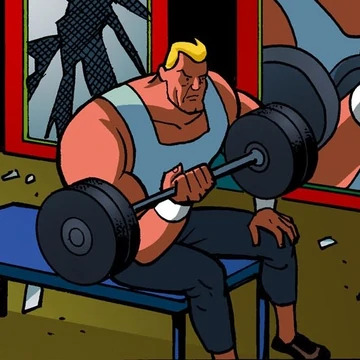
Name: Straightman Motivation: Dry Commentary, Boss’ Orders Critter Type: Human Attributes: Str 6, Dex 5, Con 5, Int 2, Per 3, Will 7 Ability Scores: Muscle 16, Combat 18, Brains 14, Life Points: 65 Drama Points: 1-3 Special Abilities: Hard to Kill 5, Criminal, Natural Toughness, Severe Cruelty, Emotionless (-2)
Name - Score - Damage – Notes Punch - 18 - 18 – Bash Brass Knuckle - 14 - 20 – Bash Pistol - 18 - 17 – Bullet
The rarest of Henchmen, only a few people fit the mold, but Joker loves them for it. Every comedian needs a straight man to go along with his gags, and “Straightman” has the best deadpan reactions around.
He’s also an extremely capable henchman.
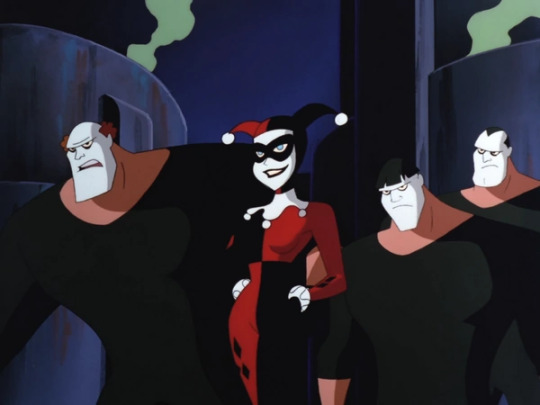
Name: Lar, Moe, Cur (and sometimes Joe) Motivation: Boss’ orders. Critter Type: Human Attributes: Str 5, Dex 4, Con 5, Int 2, Per 3, Will 4 Ability Scores: Muscle 16, Combat 14, Brains 11, Life Points: 65 Drama Points: 1-3 Special Abilities: Hard to Kill 5, Criminal, Natural Toughness, Severe Cruelty, Delusions (“Let’s have a Laugh”)
Name - Score - Damage – Notes Punch - 14 - 14 – Bash Brass Knuckle - 14 - 16 – Bash Pistol - 14 - 15 – Bullet
These are the top-tier strong guys of the Jokerz, who work directly with Mr. Jay himself. They don’t say much, but all have rather high voices despite their size and often do the “Whoo-whoop-whoop-whoop” call when running.
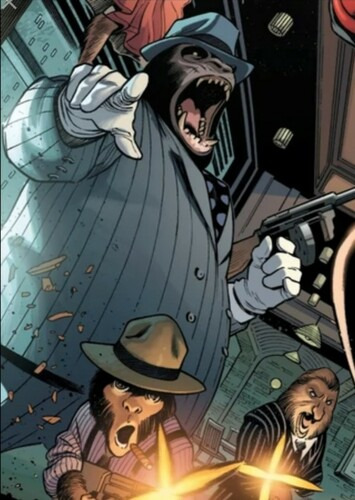
Name: Jackanapes/Gorilla Gangster of Gotham Motivation: Boss’ orders. Critter Type: Mangani Attributes: Str 8, Dex 6, Con 6, Int 2, Per 3, Will 3 Ability Scores: Muscle 24, Combat 16, Brains 11, Life Points: 81 Drama Points: 1-3 Special Abilities: Mangani, Criminal, Hard to Kill 2, Natural Toughness, Severe Cruelty, Delusions (“Let’s have a Laugh”), Wild Card (Survival) +2, Hard to Kill 3, Ambidexterity
Name - Score - Damage – Notes Punch – 16 – 20 – Bash Tommygun – 16 – 16 – Bullet Tommygun (Spray and Pray) – 16 – 12 – Bullet, 1 hit per SL. 2 Tommygun Spray and Pray – 16 – 12 – 2 hits per SL, Bullet. Rifle Butt – 16 – 28 – Bash Grapple - 18 - None - Impairments Vary Crush - 24 - 23 - Bash, Suffocation, Must Grapple First
The Joker thinks “Monkeys” are inherently funny. So, when he works his mental gymnastics with any Mangani he can manage to grab and turns them into his pawns. Some even come to him to escape the ‘primitive’ life. He thinks that’s even funnier.
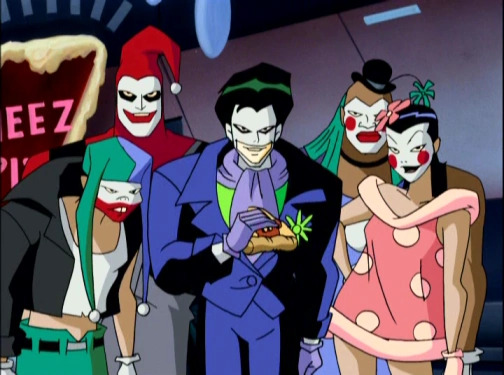
Name: Joker Boss Motivation: Fun, money. Critter Type: Human Attributes: Str 3, Dex 3, Con 4, Int 2, Per 3, Will 4 Ability Scores: Muscle 12, Combat 13, Brains 12 Life Points: 44 Drama Points: 1-3 Special Abilities: Hard to Kill 2, Wise Guy, Severe Cruelty, Delusions (“Let’s have a Laugh”)
Name - Score - Damage – Notes Punch - 13 - 9 – Bash Kick - 12 - 10 – Bash Acid - 13 - 8 - Fire damage, lasts for 1 turn per SL. Pistol - 13 - 15 – Bullet
This is the average low-level “Leader” in Joker Gangs when “The J-Man” isn’t around. Cunning, but not masterminds. Name: Joker Crook Motivation: Fun Critter Type: Human Attributes: Str 3, Dex 2, Con 3, Int 2, Per 2, Will 2 Ability Scores: Muscle 12, Combat 11, Brains 10, Life Points: 34 Drama Points: 0-1 Special Abilities: Criminal, Severe Cruelty, Delusions (“Let’s have a Laugh”)
Name - Score - Damage – Notes Knife - 11 - 8 - Slash/Stab Punch - 11 - 8 – Bash Pistol - 11 - 14 – Bullet
The average gang member.
Name: Joker Gal Motivation: Fun Critter Type: Human Attributes: Str 2, Dex 4, Con 3, Int 2, Per 2, Will 2 Ability Scores: Muscle 10, Combat 14, Brains 11, Life Points: 36 Drama Points: 1-3 Special Abilities: Hard to Kill 2, Criminal, Attractiveness +2, Severe Cruelty, Delusions (“Let’s have a Laugh”)
Name - Score - Damage – Notes Punch - 14 - 7 – Bash Club - 14 - 11 – Bash Pistol - 14 - 15 - Bullet
Ladies in the Jokerz circle all want to be the next Harley Quinn.
Name: Joker Tough Motivation: Fun Critter Type: Human Attributes: Str 4, Dex 3, Con 4, Int 2, Per 3, Will 3 Ability Scores: Muscle 14, Combat 14, Brains 11, Life Points: 48 Drama Points: 1-3 Special Abilities: Hard to Kill 2, Criminal, Natural Toughness, Severe Cruelty, Delusions (“Let’s have a Laugh”)
Name - Score - Damage – Notes Punch - 14 - 11 – Bash Brass Knuckle - 14 - 13 – Bash Pistol - 14 - 15 – Bullet
A typical Joker thug/strongman. Short on brains, high on strength.
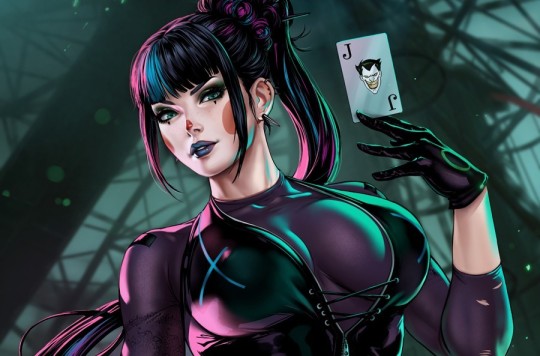
Name: Alexis Kaye a.k.a. Punchline Date of Birth: 1998 Motivation: Recruit People to the Joker's Mindset Critter Type: Human Attributes: Str 3, Dex 5, Con 4, Int 4, Per 3, Will 5 Ability Scores: Muscle 12, Combat 16, Brains 16, Life Points: 53 Drama Points: 5 Special Abilities: Hard to Kill 5, Criminal, Attractiveness +5, Deranged Cruelty, Delusions (“Let’s have a Laugh”), Nerves of Steel, Fast Reaction Time, Contacts (Criminal) 5
Name - Score - Damage – Notes Distract - 16 - None - Leaves target open to attack (reduce their Dodge to 0) Persuade - 16 - None - Opens up new possibilities Punch - 16 - 10 – Bash Switchblade - 16 - 8 - Slash/Stab Pistol - 16 - 16 - Bullet Blow Dart - 16 - 5 - Slash/Stab + Joker Venom
While many young women want to be the next Harley Quinn, only one has come close. And she did it by zigging where Harley zagged. She is less an enforcer (though she is skilled enough to act as one if need be), her true talent is in recruitment. Using forums, videos, and other online methods, she opens people up to the nihilistic destructive anarchy the Joker embodies.
6 notes
·
View notes
Text
電影星期二 32 - Hong Kong action cinema
Couple weeks ago we watched the Matrix trilogy, ahem ugh i guess quadrilogy, and back then I said, hey, these ladies were mostly riffing on Hong Kong kung fu movies (and indeed they got Yuen Woo-Ping to do the choreography) and we had better watch some of them soon. Well, the promised ‘soon’ has arrived...
So let’s go to 香港 (/ˈhɒŋkɒŋ/)! Here’s a map from Wikimedia Commons, I’ll let you find your own way:
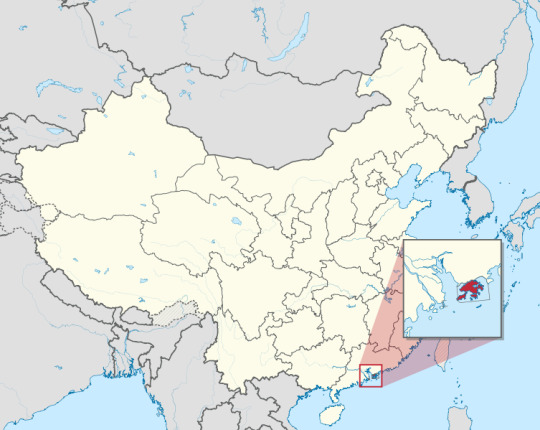
OK, so, you probably know the broad strokes: densely populated coast of China that has for a long time stood as the major interface to the global capitalist market - and the island that’s been in the news a lot recently given the anti-extradition protest movement. Do we have time to write a substantial history? Ehhhh that might be a tall order. But let’s give try and hit the main points...
Sitting on the south side of China, the story of Hong Kong is very closely connected to the story of maritime trade. So let’s start by quoting a little from Red Dust by the Chuang collective, who pass through the following summary of hundreds of years of history:
The southern coastline had long played an important role in regional trade and, after the decline of the Silk Road (with the fall of the Tang Dynasty in 907 CE), coastal trade had grown to dominate pre-capitalist commerce.[2] But there also existed strong countervailing tendencies in each dynasty that helped to mute the power exerted by the forces of commercialization. One of the most persistent threats was the transformation of these semi-illicit trade networks into independent pirate navies. By the time of the Qing (1644-1912), this threat took on the character of an anti-Manchu rebellion, led by the Ming loyalist Zheng Chenggong (known as Koxinga in the West), who had fled to the sea as the Qing armies invaded Fujian. Zheng overturned Dutch rule in Formosa (Taiwan) and turned the island into a base for his rebel navy. In response, the Qing not only banned all coastal navigation (rendering illegal a bulk of the region’s international trade), but also depopulated the coastline, deporting the population inland and razing the deserted villages in an attempt to cut off Zheng’s supply lines.[3]
Once Zheng’s rebellion was put down (in 1663 with the conquest of Taiwan), the coastline was gradually repopulated and maritime navigation resumed. This began to re-open the mainland market more directly to the nascent trade networks of the Europeans, which would soon begin to take on a distinctly capitalist character.[4] At the height of the dynasty, the mainland not only ran a healthy trade balance with the West, exporting tea, porcelain, silk and various manufactures, but also sat at the center of regional trade, with even isolationist Japan dependent on imports of raw materials from the Qing.[5] But the state had become circumspect about trade, fearing the growing power of merchants, the possibility of renewed rebellion, and the increasing capacities of the Europeans. The court therefore imposed rigorous monopolies on key goods and began to restrict foreign trade to an ever decreasing number of official customs ports. This trend reached its apex with the Canton system, from 1757 to 1842, when all foreign trade was funneled through a single port and its attached stores and warehouses (the “Thirteen Factories”) in Canton (Guangzhou).
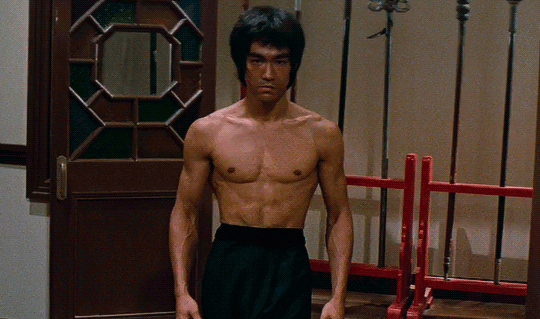
^ that’s Bruce Lee. We’ll get to him in a bit.
In 1839, the Qing attempted to crack down on opium, seizing shipments and declaring that any further attempts to sell the drug would be met with execution. Britain, riding high on imperialist capitalism and in no hurry to give up the ability to sell opium on an enormous territory, promptly invaded in an event known as the First Opium War. The war ended in a humiliating defeat for the Qing, losing major ports like Guangzhou, and in their surrender, they ceded Hong Kong as a British colony.
Over the next century, Hong Kong’s population expanded a ton thanks to civil wars like the Taiping Rebellion, which followed the old dark joke about Chinese civil wars by killing an estimated 20-30 million people and drove many people to the prosperous colony sitting right on a major trade route. Continued invasions by the European and eventually Japanese colonialists in the Second Opium War (1856-1860) and First Sino-Japanese War (1894-1895) led to Britain pressing its claims onto more and more territory, taking not just Hong Kong island itself but a significant chunk of the coast. Part of this involved an agreement to lease the islands called the ‘New Territories’ for 99 years.
(These events form part of a period mythologised as the ‘Century of Humiliation’ to both the nationalists and communists, in which the Qing and then their short-lived successor in the Republic of China suffered continual military defeats and extortionate treaties.)
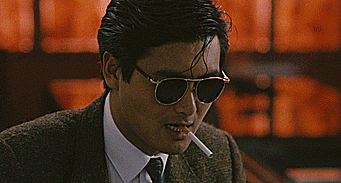
Then came the second world war; the Japanese invaded once more and displaced the British for a few years, committing rapes and atrocities which drove out about half of the population. In 1945, with their defeat, Hong Kong reverted to being a British colony. This led to a fairly different trajectory to the mainland, ruled by capitalist Britain rather than the mainland’s socialist ‘developmental regime’; it also led to divergences in language, with Hong Kong continuing to use the Traditional Chinese alphabet instead of the Simplified Chinese first introduced under Mao. (The majority language Hong Kong is Cantonese rather than Mandarin, but this is shared with several areas of the mainland.)
Hong Kong’s position as a British colony proved highly valuable for the capitalist powers in the Cold War, who invested heavily in the city in order to better contain China. This led, in Chuang’s account, to the widely described ‘flying geese’ development pattern, in which less capital-intensive industries rippled down a chain from Japan to South Korea, Hong Kong and Taiwan as each one saw a rise in wages which made labour-intensive industry less profitable. This was, they write, not at all a natural phenomenon:
Future developmental drives were therefore defined by their proximity to US political power, now facilitated by Japanese financing. In the same way that Japanese industry had been catapulted into the forefront of global production by the Korean War procurement program, industrial development in Taiwan and Hong Kong would be shaped by the military containment of the Chinese mainland.
As such, Hong Kong got built up - a lot. A particularly curious case comes in the Kowloon Walled City, a tiny Chinese enclave in between two British-controlled territories which got built up into, essentially, one enormous building. Infamous (to states!) for having almost no state control, it became home to sex work, gambling and drug use until it was transferred to the British and demolished for a park in 1987.
For propaganda purposes, Britain found it important to paint its colony as a bastion of liberal freedoms in contrast to the tyrannical Chinese Communist Party. The extent to which this is actually true is another question, and probably depends very much exactly which period of history you examine and your place in society. Until the Japanese invasion, the trade in opium was still the major source of income. Naturally, the British and American expats sat at the top of the colonial power structure; even Wikipedia writes
Although the largest businesses in the early colony were operated by British, American, and other expatriates, Chinese workers provided the bulk of the manpower to build a new port city.[38]
However, by the 80s, gradually ethnic Chinese people joined the ranks of the billionaires slurping up profit from the massive flow of trade through the port, such as Li Ka-Shing, the thirtiest richest person in the world. Meanwhile, foreign domestic workers enjoyed almost no protections. The 60s and 70s saw major leftist protests and strikes, connected with the Cultural Revolution on the mainland, which led to the colonial government implementing a series of economic reforms.
Of course, by the end of the Cold War, the balance of power between Britain and China had shifted considerably; for a variety of complicated reasons, China was becoming the capitalist world system’s major manufacturing base. As far as Hong Kong is concerned in particular, we can note the neighbouring area of Shenzhen was on its way to becoming the place where the vast majority of electronics are manufactured.
So in the late 70s, the question arose of the lease coming due for the New Territories. In 1984, Thatcher’s government agreed that the whole of Hong Kong would revert to the PRC’s control by 1997, with a promise that the economic and legal systems would stay more or less the same for at least fifty years. Inevitably the schedule seems to have moved up a lot, with the 2019 extradition bill leading to a massive-scale protest movement which enchanted anarchists abroad with their creative crowd tactics against the British-trained police... a movement which has now mostly been crushed.

Anyway, believe me, that’s the short version - as written by a British girl armed with a couple of hours, a communisation theory journal, and Wikipedia. I strongly encourage you to do your own research. What it was actually like to live through this long period is yet another question, and one I scarcely have the tools to address.
But we’re actually here to talk about movies!
The story of Hong Kong action cinema actually begins, apparently, in Shanghai, with a boom of wuxia (武俠 [ù.ɕjǎ]) novels in the 1920s-1930s about supernaturally powered figures in China’s mythological past - an enduring genre! However, these films, seen as promoting superstition, were suppressed by the Kuomintang government; the outbreak of the Civil War and the Japanese invasion further made the mainland an inhospitable place for movie-making. Unless of course you’re the absolute madlads who animated Princess Iron Fan (Animation Night 29) under Japanese bombs.
So instead, the Chinese film industry jumped a good 1226km to Hong Kong. At this point a split developed: Cantonese-language B-movies continued making wuxia, while the more prestige Mandarin-language dramas abandoned the genre. The first such Cantonese movie is The Adorned Pavilion (1938). Before long, however, wuxia found a more down-to-earth counterpart in kung fu movies. Here’s Wikipedia:
These movies emphasized more "authentic", down-to-earth and unarmed combat over the swordplay and mysticism of wuxia. The most famous exemplar was real-life martial artist Kwan Tak Hing; he became an avuncular hero figure to at least a couple of generations of Hong Kongers by playing historical folk hero Wong Fei Hung in a series of roughly one hundred movies, from The True Story of Wong Fei Hung (1949) through to Wong Fei Hung Bravely Crushing the Fire Formation (1970).[3] A number of enduring elements were introduced or solidified by these films: the still-popular character of "Master Wong"; the influence of Chinese opera with its stylized martial arts and acrobatics; and the concept of martial arts heroes as exponents of Confucian ethics.[4]

From this point both genres became incredibly prolific. The Shaw Brothers arrived in the 1960s, bringing with them a new, more acrobatic approach to wuxia films inspired by Japanese chanbara bloody samurai films and newly popular wuxia novels - and their company would go on to release over a thousand films. At this point, although the emphasis started to shift to narratives about masculinity which would come to be exemplified by the films of Chang Cheh (張易揚), women were still pretty prominent with stars like Cheng Pei-pei (鄭佩佩) and Connie Chan Po-chu (陳寶珠).
Sadly, this balance would gradually shift as, coming into the 70s, kung fu movies displaced wuxia and Hong Kong cinema started to get more of an international profile. Still, this was a period of enormous technical innovation, with ever more complex stunt work.
Time to enter Bruce Lee (李小龍)! The son of a Chinese Opera performer born during a trip abroad in San Francisco, Lee spent his childhood in Hong Kong performing in movies as a child and studying martial arts; he returned to America for his education. He became wildly famous in the 1970s with a series of movies outside of the Shaw Brothers’ monopoly, which helped to break their draconian contracts, beginning with Lo Wei's The Big Boss (1971) and Fist of Fury (1972) and then Golden Harvest's Way of the Dragon (1972) which Lee wrote and directed himself.
Golden Harvest were at the time a small upstart player, but they were propelled to prominence in 1973 with an international collaboration with Warner Bros on Enter The Dragon, and soon became the second major power in Hong Kong filmmaking, eventually displacing the Shaw Brothers. Tragically, Lee died shortly after Enter the Dragon while working on another film with director Robert Clouse, The Game of Death, which was finally released in 1978.
There followed a wave of ‘Lee clones’, with filmmakers hoping to cash in on his popularity by dressing up their stars to resemble Lee. Among them was a young Jackie Chan (房仕龍), who met little success until he collaborated with choreographer Yuen Woo-Ping on a more comedic film Snake in the Eagle's Shadow (1978), and the combination of skilfully performed kung fu and physical comedy quickly became his signature with films like Drunken Master (1978); he soon started directing his own movies, first The Fearless Hyena (1979) and gradually rose to similar fame as Lee. Alongside him rose two other comedy oriented martial arts stars:
Especially notable in this regard were two of Chan's childhood Peking Opera School classmates, Sammo Hung and Yuen Biao, who also made careers of this specialty, sometimes co-starring with Chan. Hung, noted for the seeming paradox of his overweight physique and physical agility, also made a name for himself as a director and action choreographer from early on, with titles like Enter the Fat Dragon (1978).
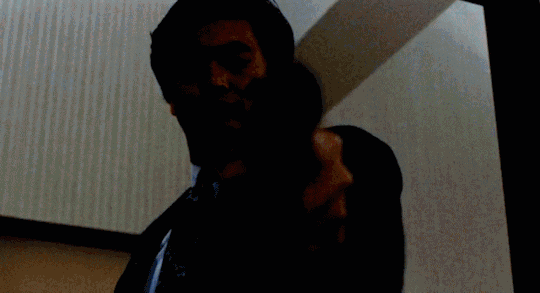
In the 80s, we have a number of new developments - you might read about them here, but alas I’m running out of time so let’s focus on the one strand that’s going to be relevant tonight! In 1979, the Shaw Brothers made a departure from their usual themes by remaking an Indian crime drama Deewaar (1975) as The Brothers (1979). This laid the foundation for a new genre: the ‘gun-fu’ or ‘heroic bloodshed’ crime films of John Woo, which took much of the visual language of the preceding kung fu films but changed the aesthetic to focus on long coats and pistols, focusing on typically on members of the triads.
The genre began with A Better Tomorrow (英雄本色) (1986), a breakout hit which promptly turned around the fortunes of martial arts star Chow Yun-fat (周潤發). In it, two friends Ho and Mark in the triad are separated when one turns himself in to buy time for a low-ranking member Shing’s escape, not realising that Shing is the one who betrayed him. Ho’s father is killed as a result, and his brother Kit, a cop, loses his chance for promotions due to his association with Ho, while Ho is injured in an attack on the traitors in the Triad and loses his standing. Three years later, on Ho’s release, he attempts to escape the life of the triad, but is pulled back in by Kit’s obsessive, ineffective pursuit of Shing; Kit meanwhile refuses to accept his brother’s attempt to change. It all comes to a head in a bloody shootout on the docks, in which Mark and Shing are killed, but Kit finally forgives Ho - who turns himself in once more.
A Better Tomorrow set the tone for a series of other movies in the 80s by Woo and others, united by similar themes of dramatic rises and falls, honourable characters in a messed up world, loyalty and brotherhood and etc. For whatever reason, similar films centring on women seem to get a different genre title as ‘girls with guns’ films - but these started at pretty much the same time with Yes, Madam (1985), and this became somewhat influential on anime.
In the 90s, these more or less romantic triad films started to die out, and wuxia made a comeback - now supported by the technical ability to perform wire stunts. By this point, Hong Kong performers were now widely known and started to leave to perform in other film industries. But we’ll come to that period on some future movie night.
What’s the plan tonight? With literally hundreds of films, it’s hard to know where to begin, but luckily @mogsk‘s expertise extends to Hong Kong action films as well, so following her advice we’ll be screening two of the most influential: Enter the Dragon (1973) and A Better Tomorrow (1986). It’s been quite a while since I saw any Hong Kong martial arts films (my old tai chi teacher was a fan and lent me some obscure ones!) so I’m really looking forward to getting an education in this the same way I did kaiju films!
So: tonight’s film night will begin very shortly! The place is, as ever, twitch.tv/canmom - hope to see you there!
17 notes
·
View notes
Text
Shang-Chi began to make a comeback in the 2000’s, escaping from the shadowy realms of C-tier superhero of the distant past and into increasing relevance. His look was all over the place as creators tried to pin down a more contemporary outfit than the old red-and-yellow Gi. A big reason for this was the revelatory success of The Matrix in 1999, a movie that tapped into Hong Kong action films and brought the action choreography of Woo Pin Yuen to mainstream audiences. Suddenly the corny old kung fu man was Cool again!
The Master of Kung Fu had a minor role in the Marvel Knights series, a comic that threw him in with a very loose affiliation of street-level heroes like Daredevil and Black Widow. He had a costume more in line with his contemporary appearances in Heroes for Hire; sleeveless, but now with more black in the outfit. I can’t say there’s a lot of great use of the character and its perhaps telling he only showed up in the background of the cover for issue #2. He’s on the periphery but rarely the focus of any of the stories.
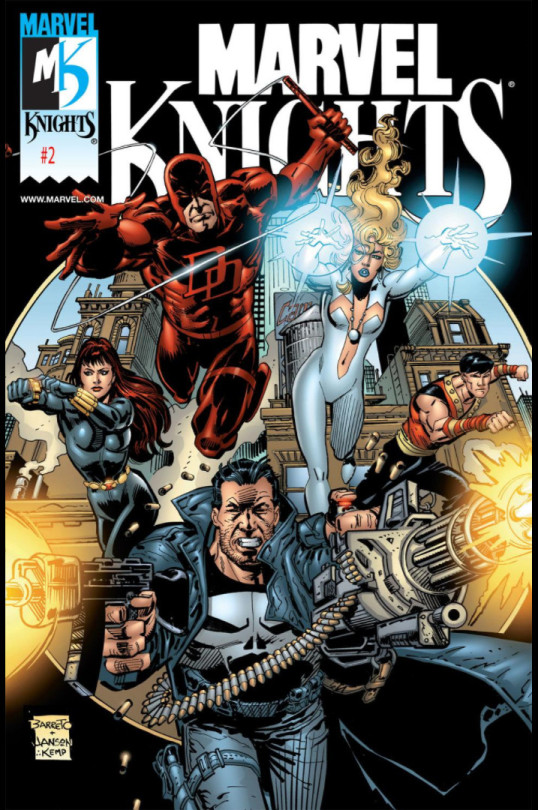
Here's Shang-Chi looking very Matrix in sunglasses and black trench coat on the cover of Shang-Chi: Master of Kung Fu, a 2002 MAX limited series from Moench and Gulacy. Don’t get too excited by the Parental Advisory notice – the adventure is pretty boiler plate Spies Vs. Fu Manchu villainy, though it was nice to see the Master of Kung Fu come back.
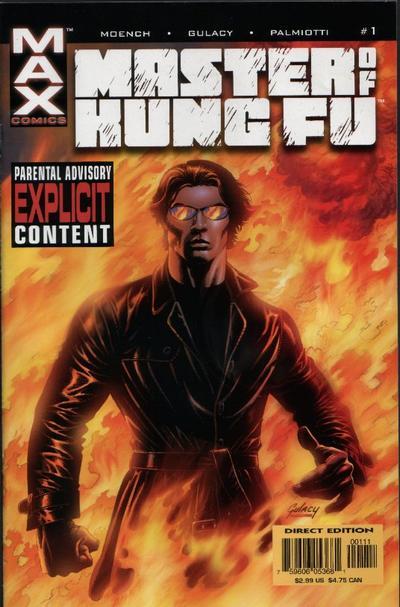
There were also apparently some plans to have Shang-Chi pick up firearms as an implement in his arsenal. This is apparently thanks to the early 2000’s fascination with Gun Fu and every hero in multiple universes suddenly deciding lethal force was Cool. I’m personally very glad they didn’t go this direction, but it is interesting to consider as an artifact of the era.
Its fitting that Shang-Chi was a featured guest in Black Panther in 2006; black American audiences were big fans of the kung fu films of the Shaw Brothers and other Hong Kong studios in the ‘70s, and there’s a lot of overlap with the Blaxploitation era with martial arts cinema. That spirit of drive-in movie fun is captured in this cover of Black Panther #11 by Mike Deodato Jr. and Dean White.
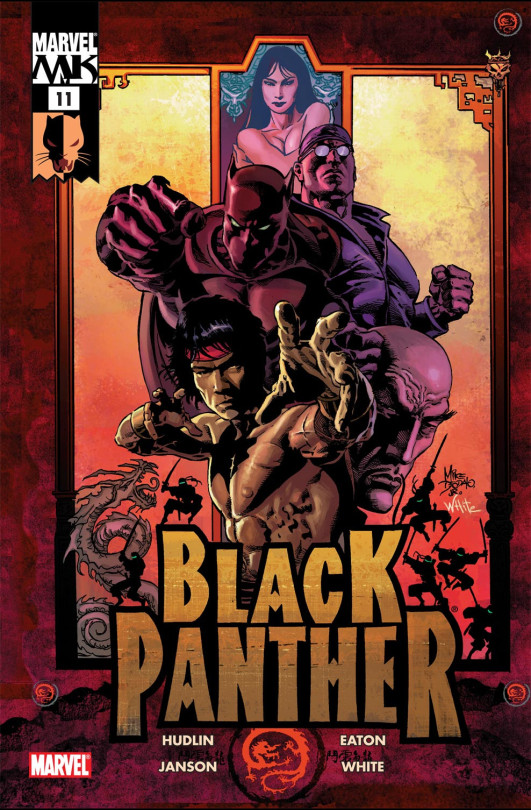
Pretty awesome! I also think this period was around when they stopped using the name Fu Manchu for Shang-Chi’s nefarious father – it’s just the start of a long wrangle with the racist history of the character and the last vestiges of the Sax Rohmer elements of Shang-Chi’s backstory.
One of the better uses of Shang-Chi in this era was his role in Heroes for Hire from 2006-2007. This iteration of the mercenary team was led by the Daughters of the Dragon, Coleen Wing and Misty Knight, two female martial artists associated with Iron Fist and Power Man. While he was teamed up with the HFH, Shang-Chi got into a complicated romantic entanglement with Maria Valasquez (Tarantula) and later killed the sometime B-tier villain Humbug after he betrayed the team. Evidence of romance here:

It’s not a whole Hell of a lot but it’s still more character development than Shang-Chi had gotten in the entire ‘90s era. He had some agency, he had some issues to work through, and he impacted the world in a way he usually didn’t get to when popping up in guest roles. His look varied throughout the run, mostly sticking to no-shirt and bloused pants.
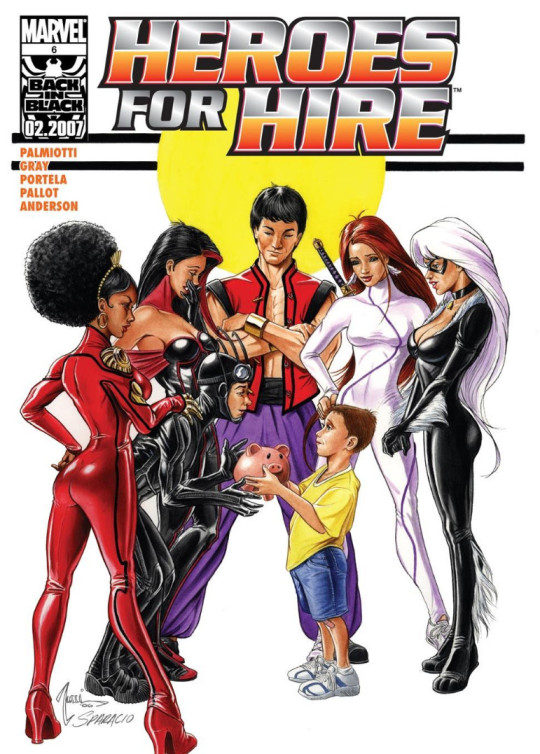
In 2009, Jonathan Hickman and Kody Chamberlain presented a one-shot team up between Deadpool and Shang-Chi. Its pretty wacky stuff but the Merc With the Mouth does give props to the Master of Kung Fu, who is presented as a more down-to-earth kind of guy, what with the sneakers and affection for hot dogs.
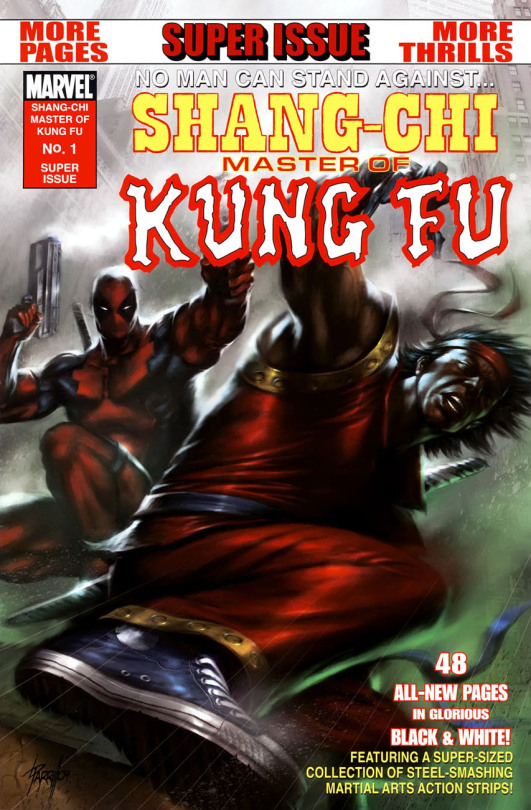
Hickman’s pretty key to Shang-Chi’s future, as we’ll see as we enter the 2010’s….
37 notes
·
View notes
Text
So the God Awful Movies podcast — whose remit is reviewing and lampooning religious cinema, with a special focus on the horrors that have been created for Christian audiences — do a monthly bonus episode reviewing an unrelated movie for their Patreon members, where they've done a couple of movies from the The Fast and the Furious franchise. They remarked, in the review of F9, on the comic relief characters noticing they really shouldn't be surviving all these over-the-top action sequences, and wondering whether they're immortal.
And since one of the two themes of the F&tF franchise is apparently "family" (the other, if I am understanding things, is "fast cars go fast"), the two got me wondering: has anyone done the legwork to tie Dom Torretto and his pals into the Wold Newton family?
(The Wold Newton family, of course, is the "discovery" of SF author Philip Jose Farmer; his books Tarzan Alive! and Doc Savage: His Apocalyptic Life postulate that the Wold Cottage Meteorite, which fell near Wold Newton in Yorkshire in 1795, caused beneficial mutations in the occupants of two passing coaches; their descendants went on to have greatly increased intelligence, strength, and drive, and included such luminaries as Sherlock Holmes, Professor James Moriarty, Phileas Fogg, John Lord Greystoke (AKA Tarzan), Solomon Kane, Allan Quatermain, A. J. Raffles, Arsène Lupin, Doctor Fu Manchu, Doc Savage, and James Bond, among a host of other literary and pulp heroes and villains. Each of Farmer's two books is a biography of the figure in question, going through all their canonical adventures and pointing out places where their "literary agents" may have disguised the real truth, and in the former work, Farmer claims to have interviewed the real figure behind the Tarzan stories, who at some point in his adventures discovered an anti-agathic medicine that kept him young and vital into at least the 1960s.)
3 notes
·
View notes
Text
Vincenzo: The Gentleman Villain Reborn
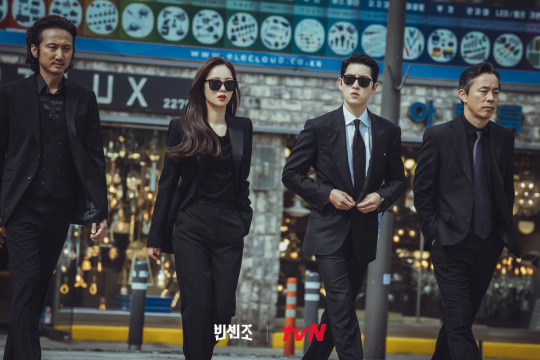
Long before there were loudmouth buff guys in spandex, there was the gentleman villain.
There once was a time when the gentleman villain, whether a gentleman thief in the Raffles or Lupin mold, or murderous arch-criminals like Fu Manchu and Fantomas, organizations like Les Vampires, and even in-between figures like Rocambole and Judex, was the coolest thing in the pop culture block. The figures right around the corner of Baker Street, when Nick Carter and Sexton Blake and any billion old serial detectives weren’t quite cutting it. Their time was not to last long in the spotlight, as the pulp heroes consolidated domain in the 30s and then the superheroes took over, but every now and then, they return in various forms, never fully gone. But I’d dare say I’d never seen a gentleman villain story quite so bold, so modern, so dynamic and so gloriously over-the-top in pride over it’s existence, until I began watching Vincenzo.
Vincenzo is BADASS and I don’t use the term lightly. Not just the titular character, but the show itself. It’s currently a couple episodes short of the finale and you should stop everything you’re doing or watching and go watch Vincenzo. It’s been an utterly glorious ride from beginning to end with no shortage of great characters, terrific writing, great relationships and jaw-dropping moments as every episode succeeds in topping each other in WOW HOLY SHIT factor. It’s a shot of adrenaline and storytelling excellence to the eyeballs and you don’t have anything better to be doing right now than watching this.
I mentioned a while ago that Black was a show that, besides being also terrific in quality, captured my interest as a Shadow fan specifically because I saw in Black what I believe is the heart of The Shadow as a character: an embodiment of evil, motivated and created and warped by social catastrophe and strife, set loose to punish true evil in order to protect humanity. In that regard, if Black is where I find the heart of The Shadow, Vincenzo is where I find the spirit of what I like about The Shadow as a series: Cathartic urban fairytales where an extraordinary agent of change, armed with incredible cunning, sleight-of-hand and combat skills, rises above a dark background to command a folk brigade of ordinary people who reveal themselves to be extraordinary through their newfound purpose, to right the wrongs of society’s predators, by being better at their tactics than they are and turning their tools against them.
I’m gonna spoil it a bit under the cut but please go watch it. I cannot praise this show enough and I’ll do my best to try.
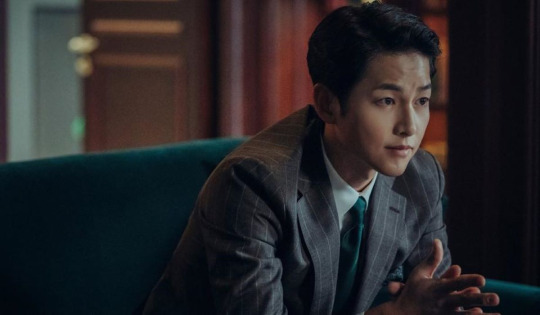
Vincenzo centers around the titular character, Vincenzo Cassano, an Italian lawyer who works for the mafia as a consigliere, adopted by it’s Don at the age of eight. After the death of the Don and an attempted betrayal by his son, Vincenzo flees to Seoul and ends up taking residence at a ramshackle building called Geumga Plaza. Geumga Plaza is the hiding place of a gigantic stash of gold hidden by one of Vincenzo’s former clients, and he intends to retrieve it to rebuild his life somewhere else. Naturally, not only is the hidden room completely impenetrable, but the building is occupied. by residents who are being forced out of it by criminals working for the Babel corporation, which intends to take possession of the building. And thus, Vincenzo has to put his skills into working out progressively bigger problems, as his efforts to uncover the gold turn into a fight against Babel and it’s lawyers, as the problems take on bigger and bigger proportions.
Vincenzo’s got a lot of what you’d expect from a k-drama at first glance. The leading man is a dashing young man, the leading lady is headstrong and stubborn, you see their romance coming a mile away and they take their damn time getting there, there’s emotional backstories that take a long time to be revealed, lots of wacky side characters and comedy interspersed with the darkest moments, a focus on corporate corruption, and so on. But it’s got an intrusion of elements brought by Vincenzo’s inclusion, such as mob drama, tonal and cultural imbalance, and the gentleman villain tropes that Vincenzo brings, as the catalyst of change whose antics backflip through action hero, romantic hero, super hero and super villain, cunning puppetmaster and gun-toting warrior alike, and start to have an effect on the world around him. His allies become stronger, more determined and effective, and the villains grow smarter and more horrid as they desperately try to avoid their own downfalls.
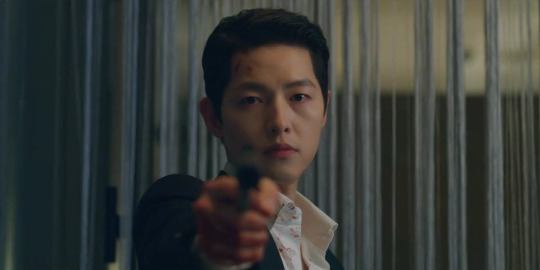
On paper, Vincenzo is almost a textbook example of how to craft a villain protagonist. He’s a mysterious foreigner with a hidden past and incredible skills who shows up uninvited in “our” world, who starts terrorizing and manipulating people into doing his bidding. He’s got a hotheaded and foolish investigator chasing after his every move, and frequently employs misdirection and sleight-of-hand to fool the authorities. He commits crimes and employs underhanded methods in the service of stamping out people worse than himself. He never really makes any claim of being a hero and actively rejects the notion he’s fighting for justice, but instead states he’s doing it as a matter of principle. One of the characters early on even states he gives off the vibe of a movie villain, even Vincenzo himself tells Hong Cha-Young, the female lead, that he’s teaching her how to be a proper villain. In another series, Vincenzo would be the hypercompetent sidekick to the main villain, or secretly the main villain, the lone badass that the action hero would have a tough fight against before defeating and moving on. But Vincenzo does not allow himself to be dismissed so easily.
On the first episode, when we’re introduced to him in Italy, he’s painted as the badass to end all badasses. But the minute he arrives in Seoul, he falls for a trick at the airport and is mugged by two cabbies, and has to walk around penniless and without dignity, shouting curses in Italian that nobody understands. He has to sleep in a broken down apartment, his “taking a steamy shower with classical music playing” fanservice scene keeps being interrupted because the shower doesn’t work, and a pigeon chattering outside his window keeps ruining his sleep.
The tenants of the building are all introduced as varying levels of unsympathetic and useless, or downright creepy. The tailor screws up his favorite suit, the chef who claims to have studied in Italy is a total fraud, there’s tenants who scare us by passing as ghosts and zombies, and Hong Cha-Young is introduced as an unlikable stooge for Babel. Vincenzo is a villain protagonist who is forced out of his grand mafia epic film, where he conducts business around lavish manors while classical music plays, and stumbles onto a korean drama, a world that operates by different rules and where no one has any reason to take him seriously at first, and gradually finds out that the difference between both worlds is not as big as he’d imagined.
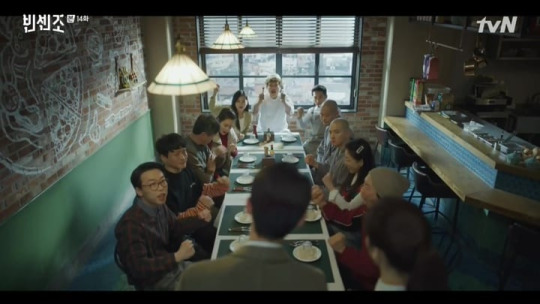
It’s only at the very end of the first episode, when the neighborhood gangsters show up to terrorize the tenants, that Vincenzo starts to kick ass again, and he has not stopped so far. In fact, not just him, ALL of the tenants have gradually started kicking ass with him. Hong Cha-Young severs all connections to Babel and proves to be, as his main partner in crime, just as cunning, twice as driven, and three times as batshit and kooky. The tailor who ruined his suit turns out to be an ex-gang member capable of fending off groups of thugs with only his scissors. The creepy piano girl reveals herself a hacking genius, the zombie impersonators become incredible actors, the failed wrestler and badass wannabe becomes his most active field agent along with his equally strong wife, the chef improves his cooking and lends his restaurant as a meeting center, all of the characters, EVERY SINGLE ONE OF THEM gradually become incredible, competent, resourceful people, really no different than they were before, it just took a little courage and pushing.
The headstrong and foolish agent pursuing Vincenzo becomes 100% smitten with him and quickly becomes one of his greatest allies. Even the neighborhood gangsters, after being left to die by Babel and forced to start anew, quickly become some of his most loyal allies, and gradually redeem themselves in the eyes of the tenants to the point they become friends. In departing from his old family, Vincenzo forms a new one, even if never by his intention. They even all get matching suits.
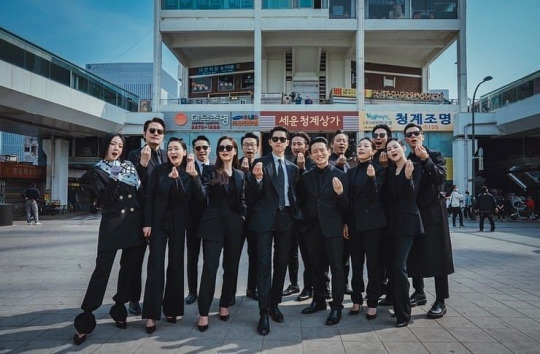
This incredibly potent, human core surrounding the antics of an extraordinary figure of action is part of what used to make the Agents of The Shadow such a special, meaningful and beloved part of the series, and something every adaptation since then has been 100% poorer for neglecting. But Vincenzo does it, and does it right. I could watch a billion adventures with these people and never get sick of them.
Vincenzo is a slick, modern take on the gentleman villain that takes many of it’s oldest conventions and provides blueprints for making them work in modern times. His plans often take a performance art-edge as he employs tactics both old-fashioned and modern, like using social media to stage an event in front of the Plaza so the bulldozers set to demolish it won’t be able to pass, or copying files and passing them to his police contact while keeping the real ones when said police contact inevitably betrays him. The tenants put all of their skills to use, no matter how unusual or seemingly useless. Every episode lays the groundwork for a smashing finale where all of the threads come together and we bare witness to a grand tapestry of karmic retribution.
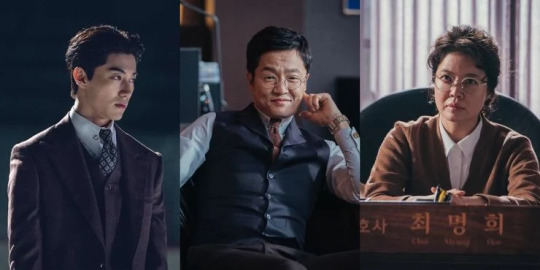
The villains themselves are no slouch, and also have that modern edge that gradually ramps up. They stage discreet assassinations involving gas leaks and watches meant to burst into flames. They stack the deck impossibly against all characters. They employ masked goons by the dozens, armies of lawyers to smudge any connections between themselves and their actions, and every sector of society in covering them, from journalists publishing pro-Babel propaganda to police commissioners. The assistant of the main villain does zumba classes amidst ordering assassinations, and is often likened to a snake and a witch with her "Crystal Ball” (the name she uses for ordering assassin contacts by the phone), complete with a cowardly, scheming assistant she bullies at every turn. The CEO of Babel has a dual nature not out of place in a Jekyll & Hyde/Dorian Grey kind of story.
The main villain is often painted as a slasher villain backed by massive corporate power, murdering people with hockey equipments and even outright named “Jason” at one point, with a tense string theme song accompanying his deeds. The show hides the villain at plain sight by using one of the most familiar set-ups of romantic dramas and the tension never stops even after he’s revealed.
Mobster films tend to paint an idealized version of it’s protagonists, not necessarily because of a genuine love or interest with mobsters (I mean, it really goes without saying that real life mobsters are obviously not admirable figures), but out of a sense of displaying a “this is what it could be” fantasy, a fantasy where the mafioso is a dark hero who will still ultimately do the right thing and stick up for the little guy, in a similar way to how superheroes often function as police officers except, y’know, actually dedicated to protecting people.
Vincenzo does go to great lengths to address the imbalance of putting such a dark figure as it’s hero, through showing how the situation can only be addressed by the intrusion of a figure such as Vincenzo. There’s a scene where Vincenzo and Hong proceed to explain extremely succintly to their cop ally why the “bad apples” argument is horseshit. One of the show’s characters, someone who’s spent his entire life being the best person he could, and dedicating himself 110% percent to fighting evil even at the expense of connecting with his own family, someone who absolutely should be the hero to take down Babel, admits shortly before dying that it wasn’t enough, that it was never going to be enough, and that what the situation calls for isn’t a hero, but a monster. That monster being Vincenzo, who is not only powerful and monstrous, but commands the loyalty of people high and low class alike, criminals and law enforcement agents, to fight Babel. In his words, “the ultimate monster”, something even the world’s biggest badass cannot defeat by himself.
On most other set-ups, Vincenzo would be pretty unmistakably the villain. But here, when he’s set up against a starkly realistic depiction of how corporations actually function in our world, depicts that Vincenzo’s ability to clear his way through goons John Wick-style is nowhere near enough, and to that end, he’s gonna have to fight impossible battles using his brains and his allies. And in the end, he defeats them, time and time again, and proves that they were not that impossible after all.
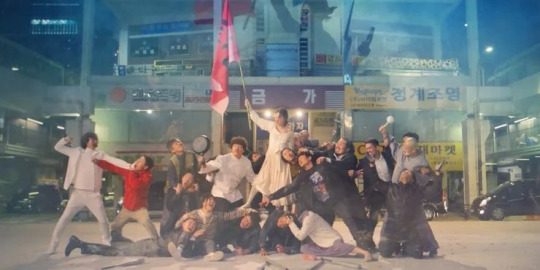
One can only hope he’s on to something.
Oh yeah and THE PIGEON BY HIS WINDOW ALSO KICKS ASS and I will not explain how, just watch the show, I can’t do it justice no matter how much I talk about it.
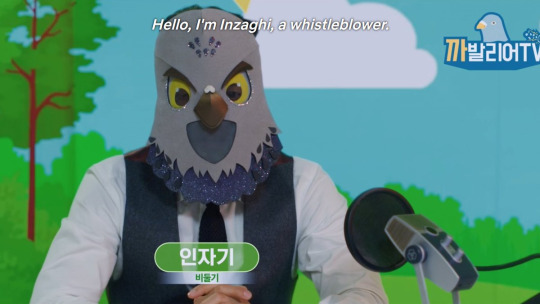
#k-drama#vincenzo#i've fallen in the k-drama rabbit hole and I am not getting back up#I love everything about this show so goddamn much#song joong ki#tvn vincenzo
50 notes
·
View notes
Text
Post 6: Paradigm Shift of Asian American Representation in Media

After decades of misrepresentation, the gendered stereotyping of Asian men and women as discussed previously, from Fu Manchu and Dragon Lady/Lotus Blossom tropes, the usage of yellowface, cultural appropriation, and the limiting of Asian actors to a few racially stereotypical roles, at last the racial barriers built by Hollywood were kicked down upon the arrival of Bruce Lee.
While Lee managed to gain some popularity with his role in the tv series The Green Hornet (1966), he was overlooked for lead roles in favor of white actors (Low, 2021). He then decided to leave the U.S. for Hong Kong to advance his career as an actor where he was catapulted to fame after the release of The Big Boss (1971) which was a huge box office success (Blake, 2018). Other films such as First of Fury (1971) and The Chinese Connection (1972) brought Lee into further spotlight which resulted in Hollywood becoming interested in him once again. After Lee revolutionized Hong Kong martial arts cinema, he went on to break through U.S. mainstream media and reconstructed the way Asians were depicted on screen by starting the “kung-fu craze” in the 70s (Desser, 2002).
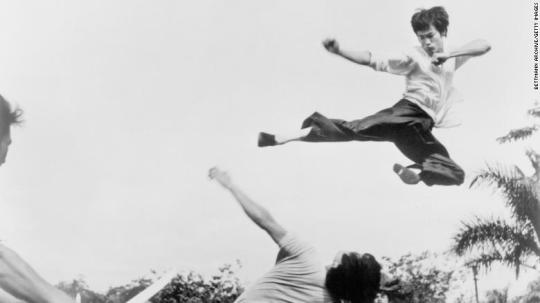
The unprecedented success of Lee marked a paradigm shift in Hollywood where Asian men, in particular, had previously been pigeonholed into roles as submissive servants, unskilled laborers, reincarnations of Fu Manchu, geeky sidekicks, unattractive, and comedy relief (Low, 2021). This paradigm shift became both a curse and a blessing as his popularity in the 1980s led to the entrenchment of the “All Asians Know Martial Arts” trope (Low, 2021). New martial arts actors that followed such as Jackie Chan and Jet Li were both referred to as “the next Bruce Lee” and martial arts films from this decade went on to inspire and influence action films and martial artists for generations after, even to this day. Bruce Lee is a prime example of the ways and possibilities that powerful stereotypes that have been around for decades can be challenged and broken and consequently change representations of Asian and Asian Americans for generations after.
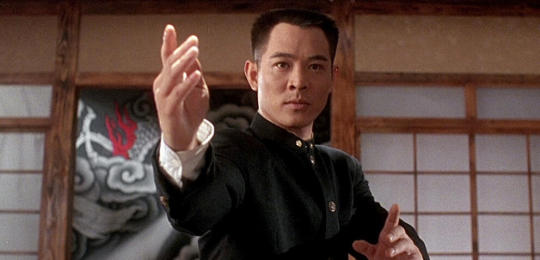
Following Bruce Lee, the year 2000 was a triumphant year for Asian cinema with Wong Kar-Wai’s In the Mood for Love premiering at the 2000 Cannes Film Festival and Ang Lee’s Crouching Tiger, Hidden Dragon also making its premiere (Low, 2021). Both films were game-changers for Asian films in international theatres but it wasn’t until the release of Crazy Rich Asians (2018) which marked a momentous step in Asian representation being the first film with an all-Asian cast since The Joy Luck Club in 1993 and breaking a record in its premiere as the highest-grossing romantic comedy in a decade (Calub, 2021). The Farewell (2019) also received praise for its authentic depiction of Asian families.

The 2020s marks the “golden age” of Asian representation in cinema, with films such as Minari (2020) winning best supporting actress Oscar for Yuh-Jung Youn (the second ever actress of Asian descent to win in that category) and showcasing an American story with characters not typically seen as American, Parasite (2019) going on to win four Oscar awards, Director Chloé Zhao winning best director for Nomadland (2020) and being chosen to direct the next epic Marvel film Eternals (2021), Shang-Chi and the Legend of the Ten Rings (2021) being the first-ever Asian-led superhero film to make it to theatres, and Squid Game (2021) being the first Korean tv show making history as the most-watched show on Netflix and topping streaming company’s drama charts in all 83 countries (Calub, 2021). All of these allowed Asians and Asian Americans to catch a glimpse of themselves on screen in a way that hasn’t really been shown before however, these films are mostly representing East Asians and not South or Southeast Asians who are still severely underrepresented in mainstream media.
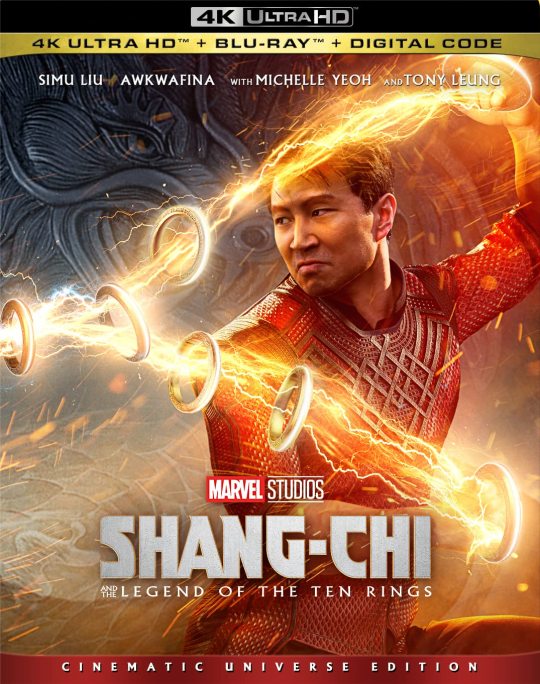
Despite these major breakthroughs in Asian cinema, a study called “I am not a Fetish or Model Minority” reviewed the top 10 grossing movies each year from 2010 to 2019, and noted that among those films, only 4.5 percent of the main cast were Asian and Pacific Islander roles which show that there is still far ways to go in Asian representation and these are just the first steps. Nancy Wang Yuen, a sociologist, told NBC “That just speaks to the lack of authority that Asians have to be able to tell their own stories in Hollywood and the kind of trope of using Asians as objects” (Calub, 2021).
To tackle issues of underrepresentation and increase diversity, Netflix released a study to analyze the makeup of Netflix’s on-screen talent including creators, producers, writers, and directors to see where it can improve on closing diversity gaps (Boorstin, 2021). The streaming platform will work on asking questions like “Whose voice is missing? Is this portrayal authentic? Who is excluded?” as it commits to an “inclusion lens” to its work (Boorstin, 2021). The company has created a fund called Creative Equity where it plans on investing $100 million over the next five years “in organizations that help underrepresented communities train and find jobs in TV and film” as well as releasing an update to this study every two years until 2026 (Boorstin, 2021). The co-CEO Ted Sarandos says “doing better means establishing even more opportunities for people from underrepresented communities to have their voices heard, and purposefully closing capacity and skill gaps with training programs where they are needed” which gives traditionally underrepresented and often misrepresented communities hope for finally being able to see a glimpse of themselves and their communities on-screen (Boorstin, 2021).
2 notes
·
View notes
Photo
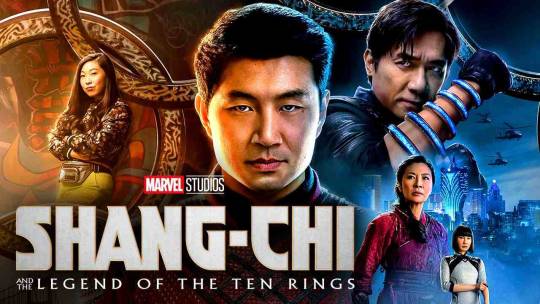
Imagine something like Iron Fist except a big budget movie and much higher quality--wait bump that, imagine what Iron Fist SHOULD have been, and you’ve got something very much like Shang-Chi and the Legend of the Ten Rings.
The Marvel Cinematic Universe does not have a great track record with Asian representation. There was the whole controversy with the Ancient One in Doctor Strange and the depiction of the Hand in the Netflix shows, it’s not been anything to brag about. So when Marvel announced they were making a big budget movie about Shang-Chi, and finally tying up that loose end about the Mandarin that Jon Favreau was building up to until Iron Man 3 killed that Plot with a sledgehammer.
And you know that’s kind of fair because I don’t know how someone would adapt the Mandarin to a live-action Iron Man film in a way that wouldn’t be offensive. I say that as someone who is not that into Iron Man comics so maybe I’m wrong, but it sounds like a pretty difficult thing to pull off. So how does one deal with it?
Why by putting him in a movie about an Asian superhero, of course!
In the comics Shang-Chi’s father is Fu Manchu and that presented a lot of problems in adapting to a wide audience: first, that Fu Manchu is an offensive Yellow Peril villain, and second (and probably more important to Disney, let’s be real) there are some issues with film rights with that character. The Mandarin is heavily based off of Fu Manchu anyway, so the MCU decided to conflate the characters. And actually make him not a Yellow Peril stereotype. And also make him a fantastic character.
Xu Wenwu was an ancient Chinese warlord who discovered the Ten Rings, armbands of unknown origins that grant their wearer eternal life and amazing powers. He built up an empire, and later a criminal empire, also called the Ten Rings, but was always after more. He learns about a hidden mystical village called Ta Lo and wants to find it to gain their cool martial arts and magic. He doesn’t even get to the door though, because the guardian Ying Li is able to beat him despite his Ten Rings. Wenwu keeps going back and ends up falling in love--he gives up the Ten Rings (the artifacts AND the organization) and marries her, and they have two children: Shang-Chi and Xialing. Except then Ying Li dies and so Xu Wenwu goes back to crime. He trains Shang-Chi to become an unbeatable killing machine when he’s a child, and when he’s a teenager sends him on a mission to assassinate an enemy of the Ten Rings.
Except Shang-Chi doesn't want that, and he runs away and years later he lives in San Francisco and works as a valet driver with his best friend Katy. It’s a basic life, but it has nothing to do with crime or killing people so he likes it. Except then the Ten Rings are after Shang-Chi, so he’s got to find his sister Xu Xialing and figure out what it is his evil father wants with them.
This, like the other MCU movies, is an action movie, but this is also a wuxia film. As a result it has some of, if not the best fight scenes out of any Marvel film. Definitely better fight choreography.
Shang-Chi is a lovable protagonist--I think had the film come out like a decade ago they would have gone out of their way to try to make him a Cool Guy type of character who is nonchalant about everything and made his entire motivation a designated love interest. Not so here! He’s a bit of a dork that would really rather be chilling out with his best friend. But he’s willing to risk everything to save the people he cares about. He’s likable, he’s relatable, and he’s fun, but not in a way that feels as if he’s some kind of sarcastic quip factory always cracking jokes. He’s a guy trying to figure out who he really is who just happens to be a badass martial artist.
Xu Wenwu is actually kind of a fantastic villain? I remember seeing articles and headlines claiming that he was a really well-developed and complex villain, and I wasn’t sure what to expect going in. People said that about Hela, for instance, and while she’s fun to watch she’s not all that complex. Xu Wenwu actually is interesting though. I will admit that it’s a bit frustrating that there’s another fridging of a female character in his backstory, but I think his character arc still mostly works and elevates him to being more than just a Fu Manchu villain that he might have been had the original angle for the Mandarin been kept. Yeah, he’s terrible, but not so much that you don’t kind of sympathize with him. I have a weakness for stories about twisted familial relationships, so I really liked his character and his arc.
I found Shang-Chi’s best friend Katy is a fun character, but that doesn’t change that her role is almost entirely comic relief. That might bother some in the audience. However unlike some comic relief characters, she isn’t useless dead weight--she contributes to the action in several scenes. Notably she’s established fairly early on as a skilled driver, and this comes up more than once as something necessary for the Plot. And she goes through her own character arc like Shang does, albeit with less development (which makes sense because one of them is the title character and the other isn’t). What I am afraid of is that a future sequel might refuse to develop her further and just fall back on her comic relief role. Which is funny, but there’s more to her than that.
There’s also Xu Xialing, Shang-Chi’s sister, and this is where the movie’s going to have some problems for some viewers. She’s not a bad character at all; she’s a great character. But her backstory--being the daughter of Xu Wenwu but not being trained as a warrior because sexism, so she taught herself martial arts, started her own little business, and can easily keep up with Shang-Chi--probably makes her a more interesting character to a lot of people, and that’s something I can’t really argue with. Which means that once again there’s a badass capable and interesting female character playing second fiddle to the male lead. That’s more than a little frustrating. I didn’t mind so much because it’s not as if she’s sidelined--she’s still an important character to the narrative and has plenty of really cool on-screen moments. But I understand that many viewers will take issue with this, and this is a recurring problem Marvel has had. There is a promise that she will feature even more in a sequel, but it’s not like Marvel always keeps its promises in that regard, and no one should have to wait on another movie to get full enjoyment of the one they’re watching right now.
And yes, this is a martial arts movie, but it is also a Marvel movie and that means that it’s very special effects heavy. You probably knew that going in, but I recall while watching the movie thinking about how there were several scenes that were probably entirely green screen. And some of them had to be, those that showed fantastical creatures and environments. I imagine that if it wasn’t a big budget feature heavy on special effects it wouldn’t have been made as a movie instead of as a television show on a streaming service. If you were hoping that the martial arts trappings would make it feel less like a Marvel movie (which I kind of was), I can’t say that this film does that. If you do like Marvel movies there’s a few little hints about what’s to come by the time the movie’s done.
Still, that doesn’t change that it’s a pretty good movie, with fantastic fight scenes, and a solid, likable cast of interesting characters who are fun to watch on screen. It’s still a Marvel movie, with all that entails, but it’s a solid entry in their cinematic universe that does something a little different--albeit not different enough to feel too foreign. I liked it. I had fun. I don't think it's a must-see unless you’re a Marvel fanatic or want to see their take on a wuxia film, but it’s a good time at the movies.
6 notes
·
View notes
Text
Shang-Chi and the Legend of the Ten Rings Review (No Spoilers):
The Good:
Main character: Shang-Chi portrayed by Simu Liu is an absolutely great protagonist. He's a likeable guy that struggles with his past and family history. He's an extremely down to earth character and it just makes him feel relatable. I've never seen this actor before, but with his performance here he definitely because one to watch.
Supporting Cast- The supporting cast in this movie works will. Shang's best friend Katy, played by Awkwafina, comes off very well as the comic relief character that actually has layers and a purpose for being around. You also buy into their friendship. Shang's Xialang also feels like character that, while she may felt left out of big emotional arcs in this movie, is poised for larger roles in the future. A few other side characters really stand out, but without spoilers I can't talk too much about that.
The Antagonist- Wenwu played by the astonishing Tony Leung Chiu-wai was an absolutely brilliant villain. Wenwu is actually a mash up of two comic villains, Fu Manchu and The Mandarin. Wenwu comes off as menacing, ruthless, and terrifying, but also caring and heartbroken. It's a character with so many layers and it was brought to life so well. Wenwu will be one of marvels most memorable villains and tbh, makes this movie work.
The action- The choreography in this movie was absolutely amazing. You can tell that everyone on screen knew what they were doing as far as martial arts goes. Some of the best fight scenes MCU was going to bring to you.
The tone- Shang-Chi actually managed to get down a very distinct tone. Don't get me wrong, it does feel like an MCU movie, but it has its own voice and its own direction that's going to make it very unique to any other MCU movie. Watching this movie I got very much old school Jackie Chan movie vibes. I think it really worked well for the overall tone of this movie.
The soundtrack- Very unique soundtrack that did not feel out of place. I'm very big on how movie sounds and if the soundtrack is off I notice it immediately.
The Bad:
The final set piece- I felt like the final fight in this movie, while gorgeous, definitely fell short for me. It I'm not too big a fan of big CGI spectacles. So if you have that same mindset you probably won't complete the enjoy the ending fight. It was gorgeous and very well done but not my cup of tea.
Supporting Antagonist- I felt like the supporting antagonists were just there to be henchmen. For instance if there's one character that you can tell was very traumatic in Shang's childhood and I felt like you didn't get a payoff with that character. We got a cool action singer too with that character but I felt like they fell short on that villain. This movie was clearly the Wenwu shown everyone else was just there to back him up.
The runtime- I didn't think the movie needs to be as long as it was. There's some down time in moments and they're important but maybe we ahouldn't have spent so long during certain sequences.
Additional info:
There are two after credit scenes, it's a marvel movie duhh. Stick around for those because they've got some big story elements to the futures of certain characters in this movie.
Lots of Easter eggs for certain comics or even past MCU movies.
The verdict:
Shang-Chi and the Legend of the Ten Rings was a very well done action adventure movie with layers and nuance to it. The movie shines the most when it has something to say about family, and culture, and needing to accept all parts of your past in order to make yourself whole. It was an extremely enjoyable watch and I would definitely recommend it to friends and family.
8/10
5 notes
·
View notes